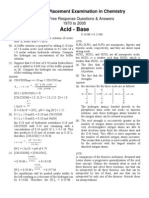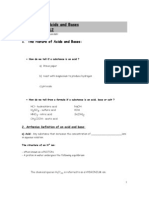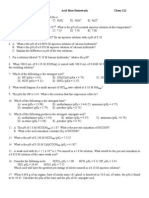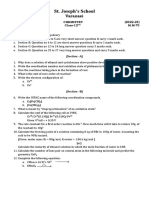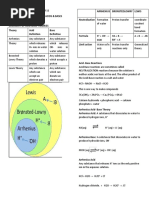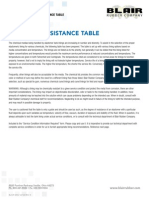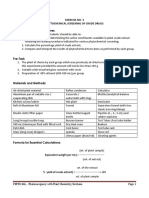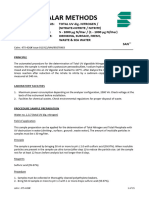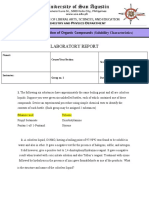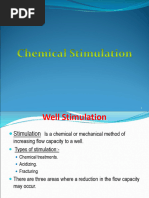Acids, Bases and Salts Notes - X
Acids, Bases and Salts Notes - X
Uploaded by
LizannCopyright:
Available Formats
Acids, Bases and Salts Notes - X
Acids, Bases and Salts Notes - X
Uploaded by
LizannOriginal Description:
Original Title
Copyright
Available Formats
Share this document
Did you find this document useful?
Is this content inappropriate?
Copyright:
Available Formats
Acids, Bases and Salts Notes - X
Acids, Bases and Salts Notes - X
Uploaded by
LizannCopyright:
Available Formats
ACIDS, BASES AND SALTS
NOTES - X
Acids: Chemical substances which have a sour taste and change the color of
blue litmus to red.
Bases: Chemical substances which have a bitter taste and change the color of
red litmus to blue.
Indicators: Substances which determine the nature of a substance by changing
its color or odour.
i. Natural indicators: Indicators obtained from plants or animals.
Ex: Litmus, turmeric etc,.
ii. Synthetic indicators : Artificially prepared indicators.
Ex: Methyl orange, phenolphthalein
iii. Olfactory indicators: Indicators which determine the nature of a
substance by changing their odour.
Ex: Onion, vanilla etc,.
THE CHEMICAL PROPERTIES OF ACIDS AND BASES
1. Reaction with metals
Acid + Metal → Salt + Hydrogen gas
H2SO4 +Zn → ZnSO4 +H2
❖ In the above reactions metal displaces hydrogen from the acids.
❖ Since acids react with metals to form salt and hydrogen gas, the
substances containing acids should not be kept in metal containers.
Base + Metal → Salt + Hydrogen gas
❖ Not all metals react with bases. Usually Zn and Al show reactivity
towards the bases.
Ex: 2NaOH + Zn → Na2ZnO2 + H2
(Sodium zincate)
2. Reaction of metal carbonates and metal hydrogen carbonates with acids
❖ All metal carbonates and hydrogencarbonates react
with acids to give a corresponding salt, carbon
dioxide and water.
Metal carbonate/Metal hydrogencarbonate + Acid → Salt + Carbon dioxide +
Water
➢ Na2CO3(s) + 2HCl(aq) → 2NaCl(aq) + H2O(l) + CO2( g )
➢ NaHCO3(s) + HCl(aq) → NaCl(aq) + H2O(l) + CO2( g )
❖ Test for carbon dioxide gas : On passing the carbon dioxide gas
evolved through lime water, the lime water turns milky due to the
formation of white precipitate of CaCO3.
➢ Ca(OH)2(aq) + CO2(g) → CaCO3(s) + H2O(l)
(Lime water) ( White precipitate )
❖ On passing excess carbon dioxide the milkiness disappears
due to the formation of Ca(HCO3)2 which is soluble in
water.:
➢ CaCO3(s)+ H2O(l)+ CO2(g) →Ca(HCO3)2(aq)
( Soluble in water )
3. Reaction between acids and bases
❖ The reaction between an acid and a base to give a salt and water is
known as a neutralisation reaction.
Base + Acid → Salt + Water
➢ NaOH(aq) + HCl(aq) → NaCl(aq) + H2O(l)
4. Reaction of Metallic Oxides with Acids
(Metal oxides are basic in nature, so they react with acids)
Metal oxide + Acid → Salt + Water
➢ CuO + 2HCl → CuCl2 + H2O
blue-green colour
❖ The colour of the solution becomes blue green and
the copper oxide dissolves. The blue-green colour of
the solution is due to the formation of copper(II)
chloride in the reaction.
❖ Since metallic oxides react with acids to give salts and water, similar to
the reaction of a base with an acid, metallic oxides are said to be basic
oxides.
5. Reaction of a Non-metallic Oxide with Base
Non metal oxide + Base → Salt + Water
Ex: Calcium hydroxide, which is a base, reacts with
carbon dioxide to produce a salt and water.
➢ CO2(g) + Ca(OH)2(aq) → CaCO3(s) + H2O(l)
(Lime water) ( White precipitate )
❖ Since this is similar to the reaction between a base and
and acid, we can conclude that nonmetallic oxides are
acidic in nature.
Acids / bases in water
❖ In the presence of water, all acids give H+ ions.
HCl + H2O → H3O+ + Cl–
❖ As H+ ions cannot exist alone, it combines with water molecules and
form H3O+ (hydronium ion).
H+ + H2O → H3O+
❖ In the same way, in presence of water, bases give OH- ion.
❖ All bases do not dissolve in water.
❖ Bases which are soluble in water are called alkalis.
❖ As we have identified that all acids generate H+( aq) and all bases
generate OH- ( aq), we can view the neutralisation reaction as follows –
Acid + Base → Salt + Water
H X + M OH → MX + HOH
H+(aq) + OH– (aq) → H2O(l)
❖ The process of dissolving an acid or a base in water is a highly
exothermic one. Care must be taken while mixing concentrated nitric acid
or sulphuric acid with water. The acid must always be added slowly to
water with constant stirring. If water is added to a concentrated acid, the
heat generated may cause the mixture to splash out and cause burns. The
glass container may also break due to excessive local heating.
Dilution: Mixing an acid or base with water results in decrease in the
concentration of ions (H3O+/OH–) per unit volume. Such a process is called
dilution and the acid or the base is said to be diluted.
Preparation of HCl gas (Refer activity 2.9, fig 2.4)
➢ Take about 1g solid NaCl in a clean and dry test tube.
➢ Add some concentrated sulphuric acid to the test tube.
➢ We can observe a gas coming out of the delivery tube.
➢ Test the gas evolved successively with dry and wet blue litmus paper.
➢ We can observe that only wet litmus paper shows change in colour.
➢ Inference about the acidic character of:
(i) dry HCl gas : do not show acidic character due to the absence of water.
(ii) HCl solution : H+ ions are produced in the presence of water and thus shows
acidic character.
➢ Conclusion: This experiment suggests that hydrogen ions in HCl are
produced only in the presence of water. The separation of H+ ion from
HCl molecules cannot occur in the absence of water.
Strength of an acid or base
❖ Strength of an acid or base depends on the number of H+ ions or OH-
ions produced by them respectively.
pH scale: The scale for measuring hydrogen ion concentration in a solution.
❖ Values more than 7 on the pH scale represent a basic solution.
❖ If pH = 7, solution is neutral.
❖ If pH >7, solution is basic.
❖ If pH < 7, solution is acidic.
❖ Higher the hydronium ion concentration in a solution, lower is its pH.
❖ Generally paper impregnated with the universal indicator is used for
measuring pH.
❖ Acids that give rise to more H+ ions are said to be strong acids, and acids
that give less H+ ions are said to be weak acids.
❖ Bases that give rise to more OH-ions are said to be strong bases, and
acids that give less OH- ions are said to be weak bases.
Importance of pH in Everyday Life
❖ Our body works within the pH range of 7.0 to 7.8. Living organisms can
survive only in a narrow range of pH change.
❖ When pH of rain water is less than 5.6, it is called acid rain. When acid
rain flows into the rivers, it lowers the pH of the river water. The survival
of aquatic life in such rivers becomes difficult.
❖ Plants require a specific pH range for their healthy growth.
❖ Our stomach produces hydrochloric acid. It helps in the digestion of food
without harming the stomach. During indigestion the stomach produces
too much acid and this causes pain and irritation. To get rid of this pain,
people use bases called antacids. These antacids neutralise the excess
acid. Magnesium hydroxide (Milk of magnesia), a mild base, is often
used for this purpose.
❖ Tooth decay starts when the pH of the mouth is lower than 5.5. Tooth
enamel, made up of calcium phosphate is the hardest substance in the
body. It does not dissolve in water, but is corroded when the pH in the
mouth is below 5.5. Bacteria present in the mouth produce acids by
degradation of sugar and food particles remaining in the mouth after
eating. The best way to prevent this is to clean the mouth after eating
food. Using toothpastes, which are generally basic, for cleaning the teeth
can neutralise the excess acid and prevent tooth decay.
❖ Bee-sting leaves an acid which causes pain and irritation. Use of a mild
base like baking soda on the stung area gives relief.
Salts
❖ Salts are produced by the neutralization reaction between acid and base.
❖ Salts of a strong acid and a strong base are neutral with pH value of 7.
❖ Salts of a strong acid and weak base are acidic with pH value less than 7.
❖ Salts of a strong base and weak acid are basic in nature, with pH value
more than 7.
Chemicals from Common Salt
Chlor-alkali process
When electricity is passed through an aqueous solution of sodium chloride
(called brine), it decomposes to form sodium hydroxide. The process is called
the chlor-alkali process because of the products formed– chlor for chlorine and
alkali for sodium hydroxide.
2NaCl(aq) + 2H2O(l) → 2NaOH(aq) + Cl2(g) + H2( g )
➢ Chlorine gas is given off at the anode.
➢ Hydrogen gas at the cathode.
➢ Sodium hydroxide solution is formed near the cathode. The three
products produced in this process are all useful.
➢ (Refer fig.2.8 – Uses of the products of chlor-alkali process)
Bleaching powder – Calcium oxychloride (CaOCl2)
❖ Bleaching powder is produced by the action of chlorine on dry slaked
lime [Ca(OH)2] .
Ca(OH)2 + Cl2 → CaOCl2 + H2O
Uses
➢ For bleaching cotton and linen in the textile
industry.
➢ For bleaching wood pulp in paper factories.
➢ For bleaching washed clothes in laundry.
➢ As an oxidising agent in many chemical industries.
➢ For disinfecting drinking water to make it free of
germs
Baking soda - sodium hydrogencarbonate (NaHCO3)It is produced using
sodium chloride as one of the raw materials.
NaCl + H2O + CO2 + NH3 → NH4Cl + NaHCO3
(Ammonium ( Sodium
chloride)hydrogencarbonate)
❖ It is a mild non-corrosive base.
❖ The following reaction takes place when it is heated
during cooking –
2NaHCO3 Heat
→ Na2CO3+H2O+CO2
(Sodium ( Sodium
hydrogencarbonate) carbonate)
Uses
➢ For making baking powder, which is a mixture of baking soda (
sodium hydrogencarbonate) and a mild edible acid such as tartaric
acid. When baking powder is heated or mixed in water, the
following reaction takes place –
NaHCO3 + H+ → CO2 + H2O + Sodium salt of acid
(From any acid)
Carbon dioxide produced during the reaction causes bread or cake to
rise making them soft and spongy.
➢ Sodium hydrogencarbonate is also an ingredient in antacids. Being
alkaline, it neutralises excess acid in the stomach and provides
relief.
➢ It is also used in soda-acid fire extinguishers.
Washing soda –Sodium carbonate ( Na2CO3.10H2O)
❖ Sodium carbonate can be obtained by heating baking
soda. Recrystallisation of sodium carbonate gives
washing soda. It is also a basic salt.
Na2CO3 + 10H2O→Na2CO3.10H2O
(Sodium
carbonate)
Uses
➢ Sodium carbonate (washing soda) is used in glass, soap and paper
industries.
➢ It is used in the manufacture of sodium compounds such as borax.
➢ Sodium carbonate can be used as a cleaning agent for domestic purposes.
➢ It is used for removing permanent hardness of water.
Water of crystallization- It is the fixed number of water molecules present
in one formula unit of a salt.
❖ Example: Five water molecules are present in one formula unit of copper
sulphate. Chemical formula for hydrated copper sulphate is
Cu SO4. 5H2O.
❖ Other salt, which possesses water of crystallisation is gypsum.It has two
water molecules as water of cyrstallisation. It has the formula
CaSO4.2H2O.
Plaster of Paris - calcium sulphate hemihydrate (CaSO4. H2O)
❖ On heating gypsum at 373 K, it loses water molecules and becomes
calcium sulphate hemihydrate.
❖ Plaster of Paris is a white powder and on mixing with water, it changes to
gypsum once again giving a hard solid mass.
CaSO4 .1/2H2O +1 1/2H2O→CaSO4 .2H2O
(Plaster of Paris) (Gypsum)
Uses
➢ Plaster of Paris, the substance which doctors use as plaster for supporting
fractured bones in the right position.
➢ Plaster of Paris is used for making toys and materials for decoration.
➢ It is also used for making surfaces smooth.
********God Bless You********
You might also like
- Screening of Reactive Sulfides in Waste: Standard Test Methods ForDocument3 pagesScreening of Reactive Sulfides in Waste: Standard Test Methods ForSandipGangurdeNo ratings yet
- Ap Chem Free Response Answers Acid BaseDocument20 pagesAp Chem Free Response Answers Acid BaseChristina Nguyen50% (2)
- 10 1 ProbabilityDocument2 pages10 1 Probabilityapi-25931785No ratings yet
- Assignment ChemistryDocument12 pagesAssignment ChemistrySayyad Dawar100% (1)
- Chapter 1 Practice Test BDocument3 pagesChapter 1 Practice Test Bmcmahs01No ratings yet
- Acids Base Equilibria NEHDocument123 pagesAcids Base Equilibria NEHLulwa KhaskiehNo ratings yet
- Chemistry - MCQDocument30 pagesChemistry - MCQjoydeep_d32320% (1)
- Problem Set (Acids and Bases Buffers and Titrations.)Document8 pagesProblem Set (Acids and Bases Buffers and Titrations.)Nate JamesNo ratings yet
- A1 Ch19studyguideDocument3 pagesA1 Ch19studyguideJana Aldour100% (2)
- Element Charge Element Charge: SeleniumDocument1 pageElement Charge Element Charge: SeleniumDiana MaeNo ratings yet
- Multiple Choice QuestionsDocument39 pagesMultiple Choice QuestionsFatma JamalNo ratings yet
- Acids & BasesDocument32 pagesAcids & BasesLechimiNo ratings yet
- Review Chemical Reactions Test Chap 7Document2 pagesReview Chemical Reactions Test Chap 7townsenr94No ratings yet
- Chapter 9Document12 pagesChapter 9Eubin ChoiNo ratings yet
- Dimensional Analysis Practice ProblemsDocument4 pagesDimensional Analysis Practice ProblemsAngel SolivanNo ratings yet
- Acid Base Note01-10 StudentDocument28 pagesAcid Base Note01-10 Studentc_66hsia7505No ratings yet
- Titration Curves: Strong Acid-Strong Base TitrationsDocument15 pagesTitration Curves: Strong Acid-Strong Base TitrationssandalailaNo ratings yet
- Lesson 3: Rates of Change in Linear & Quadratic Functions: The Average Rate of Change and The Secant LineDocument6 pagesLesson 3: Rates of Change in Linear & Quadratic Functions: The Average Rate of Change and The Secant LineLauren DarbyNo ratings yet
- Quiz 1.4Document3 pagesQuiz 1.4hjNo ratings yet
- StoichiometryDocument10 pagesStoichiometryvanditNo ratings yet
- Electrochemistry Test From Online Source AnswersDocument32 pagesElectrochemistry Test From Online Source AnswersglaubersgNo ratings yet
- Acid Base HomeworkDocument5 pagesAcid Base HomeworkAriel ChuNo ratings yet
- 12 ChemistryDocument4 pages12 ChemistryUnwantedNo ratings yet
- Molecular Geometry VseprDocument7 pagesMolecular Geometry VseprWylie Thomas PeNo ratings yet
- AP Chemistry FR Test BankDocument7 pagesAP Chemistry FR Test BankzeustamNo ratings yet
- L6 U3 SNC1D NotesDocument6 pagesL6 U3 SNC1D NotesabhieNo ratings yet
- Bonding Questions 1Document5 pagesBonding Questions 1Tarek FaramawyNo ratings yet
- Chapter 4-Chemical ReactionsDocument39 pagesChapter 4-Chemical ReactionsGörkem Damdere100% (1)
- PH and BufferDocument68 pagesPH and BufferDileesha WeliwaththaNo ratings yet
- Table of Contents - Exam Review Packet (Teacher's Version)Document122 pagesTable of Contents - Exam Review Packet (Teacher's Version)Chelle VillasisNo ratings yet
- Stoichiometry ProblemsDocument4 pagesStoichiometry Problemsphilippeprean0% (1)
- Endocrine SystemDocument2 pagesEndocrine SystemEldie OcarizaNo ratings yet
- Titration Problems - AP ChemistryDocument8 pagesTitration Problems - AP ChemistryReeNo ratings yet
- Chemistry Quiz One NotesDocument7 pagesChemistry Quiz One NotesCourseCentralNo ratings yet
- Solubility Notes Unit 3Document17 pagesSolubility Notes Unit 3cutecatmaryamNo ratings yet
- Bonding PacketDocument24 pagesBonding PacketIra Munirah100% (2)
- CH 15Document58 pagesCH 15Chala1989No ratings yet
- NH 3 H 2 o Oh NH 4 Acid Base Concepts Chapter 15 H Conjugate Acid Base Pairs H Base AcidDocument12 pagesNH 3 H 2 o Oh NH 4 Acid Base Concepts Chapter 15 H Conjugate Acid Base Pairs H Base AcidKhang TrầnNo ratings yet
- Chemical Reactions: Amedeo Avogadro 1776-1856Document38 pagesChemical Reactions: Amedeo Avogadro 1776-1856ade dosmaria100% (1)
- 3 Acids & BasesDocument24 pages3 Acids & BasesAbdul Quddus100% (1)
- Chemical KineticsDocument169 pagesChemical KineticsHope World100% (1)
- The MoleDocument3 pagesThe MoleFatema KhatunNo ratings yet
- Cq3 Change and Matter KeyDocument5 pagesCq3 Change and Matter KeyhugoaguilarbNo ratings yet
- Module Acids, Bases, SaltsDocument7 pagesModule Acids, Bases, SaltsAndy TanNo ratings yet
- Classification of MatterDocument41 pagesClassification of MatterRicardo Jr. Uy100% (1)
- Ch. 6 and 17 Practice TestDocument12 pagesCh. 6 and 17 Practice TestShashwat ChakrabortiNo ratings yet
- CH 14 Study GuidesDocument10 pagesCH 14 Study Guides4b00d1No ratings yet
- Chapter 1 Practice TestDocument3 pagesChapter 1 Practice Testmcmahs01100% (1)
- Atom Building GameDocument22 pagesAtom Building GameEsat GoceriNo ratings yet
- CMC Chapter 11Document58 pagesCMC Chapter 11Marah Omar50% (2)
- Balancing Chemical Equations AnswersDocument2 pagesBalancing Chemical Equations Answersjj siwaNo ratings yet
- Molecular Geometry Memorize ShapeDocument6 pagesMolecular Geometry Memorize ShapeosvaldocossioNo ratings yet
- History 23.2Document2 pagesHistory 23.2ayeshaNo ratings yet
- Acid and BaseDocument28 pagesAcid and BaseReeja MathewNo ratings yet
- Chem 1 Week 3 Chemical Equations CompilerDocument11 pagesChem 1 Week 3 Chemical Equations CompilerMelcorr MontesclarosNo ratings yet
- Choice ADocument1 pageChoice Aapi-295097927No ratings yet
- Self-Ionization of WaterDocument4 pagesSelf-Ionization of WaterisallehNo ratings yet
- Physics Chapter 7 - Test ADocument4 pagesPhysics Chapter 7 - Test ACamdrn WrightNo ratings yet
- Chemistry Honors Final Review WorksheetDocument12 pagesChemistry Honors Final Review Worksheetjb12355No ratings yet
- Practice Makes Perfect in Chemistry: Kinetics and Equilibrium with AnswersFrom EverandPractice Makes Perfect in Chemistry: Kinetics and Equilibrium with AnswersNo ratings yet
- 6a. Official Inorganic Acids - BasesDocument7 pages6a. Official Inorganic Acids - BasesKim Xiarisse BalugayNo ratings yet
- PH IndicatorDocument12 pagesPH IndicatorcarmelashleyNo ratings yet
- D 1439 03 Standard Test Methods For Sodium Carboxymethylcellulose PDFDocument9 pagesD 1439 03 Standard Test Methods For Sodium Carboxymethylcellulose PDFJuan SersopulosNo ratings yet
- Chemical Resistance TableDocument6 pagesChemical Resistance TableEdgarDavidDiazCamposNo ratings yet
- Equilibrium 1Document31 pagesEquilibrium 1Viren W.No ratings yet
- 2023-2024-Class X-Chemistry-Part 1-AWDocument159 pages2023-2024-Class X-Chemistry-Part 1-AWSinora DsouzaNo ratings yet
- Ionic Equilibrium WSDocument20 pagesIonic Equilibrium WSVishal MNo ratings yet
- 2 Catsafst6 (Advance Pattern) Paper-2 PDFDocument14 pages2 Catsafst6 (Advance Pattern) Paper-2 PDFAvishek BiswasNo ratings yet
- Lab Report 1Document3 pagesLab Report 1Kushani HasinikaNo ratings yet
- Yr 7 Acids&alkaliDocument33 pagesYr 7 Acids&alkaliYumni AminNo ratings yet
- Athira Innovative LessonDocument7 pagesAthira Innovative Lessongeetha100% (1)
- Exercise No. 3 PHYTOCHEMICAL SCREENING OF CRUDE DRUGSDocument11 pagesExercise No. 3 PHYTOCHEMICAL SCREENING OF CRUDE DRUGSKarren ReyesNo ratings yet
- Sodium Hydroxide, Pellets, Reagent ACS MSDS: Section 1: Chemical Product and Company IdentificationDocument6 pagesSodium Hydroxide, Pellets, Reagent ACS MSDS: Section 1: Chemical Product and Company IdentificationyoukahoNo ratings yet
- Chem 11200 Study Guide Revised 2016 V3Document5 pagesChem 11200 Study Guide Revised 2016 V3JessicaNo ratings yet
- AminoBion Communication BriefDocument5 pagesAminoBion Communication BriefvismayaNo ratings yet
- Experiment 8Document5 pagesExperiment 8Rohit BiswasNo ratings yet
- VSS, Chem., B.SC - Sem.I, Structure and Bonding NotesDocument29 pagesVSS, Chem., B.SC - Sem.I, Structure and Bonding NotesKushma KushmaNo ratings yet
- Total UV NitrogenDocument15 pagesTotal UV Nitrogenadityakapuriya11No ratings yet
- Qualitative Analysis (Basic Redicals)Document36 pagesQualitative Analysis (Basic Redicals)gd MNo ratings yet
- Carboxylic Acids and The Acidity of The O-H BondDocument48 pagesCarboxylic Acids and The Acidity of The O-H BondPaolo PepsNo ratings yet
- Module 10 Lab: Identification of Organic CompoundsDocument5 pagesModule 10 Lab: Identification of Organic CompoundsNorab, tebmaNo ratings yet
- SD7000 InstructionsDocument8 pagesSD7000 InstructionsMarcelo CheloNo ratings yet
- Chemistry FullDocument7 pagesChemistry FullrimshaNo ratings yet
- Alchemy in The Roasting Lab Discovering Organic Acids (Part 2 of 2) by Joseph A. RiveraDocument3 pagesAlchemy in The Roasting Lab Discovering Organic Acids (Part 2 of 2) by Joseph A. RiverasuonodimusicaNo ratings yet
- 202324S1_22003285_Expt 6_Lab ReportDocument8 pages202324S1_22003285_Expt 6_Lab ReportSumayyahNo ratings yet
- Chemical StimulationDocument99 pagesChemical StimulationLlike Us BravoNo ratings yet
- Researchpaper 18 Amlodipine AjcDocument10 pagesResearchpaper 18 Amlodipine AjcEVELYN SOLANHS ACERO RODRIGUEZNo ratings yet
- Scicent SQ U9 3 SetA Final eDocument5 pagesScicent SQ U9 3 SetA Final eShirley TamNo ratings yet
- Neutralization & Dilution Tank For Laboratory WasteDocument2 pagesNeutralization & Dilution Tank For Laboratory WasteYoke ShuNo ratings yet

